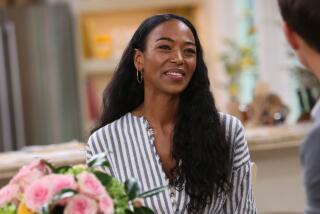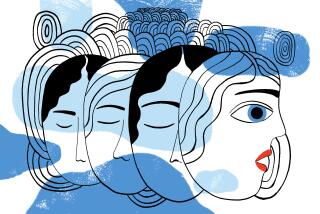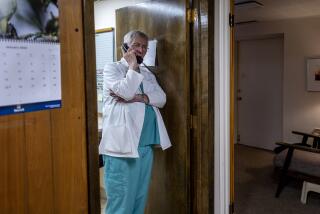In the Aftermath of Breast Cancer Surgery, a âSisterhoodâ Rallies : Health: The women call themselves a support group. But the co-mingling of their lives goes much deeper, to the very core.
ESTES PARK, Colo. â They look like a quartet of sorority sisters gathered for a reunion: a few gray hairs, some crowsâ feet around the eyes, a telltale liver spot or two on the hands. Otherwise, theyâre trim and chic, toned and tanned, the image of vibrant middle-age American women on the go.
Then B. J. Lee tugs at her wig, doesnât like the way it fits, and pulls it off. She is bald. Nobody notices. Stephanie Raukâs hair is a mass of inch-long spikes sticking out of her skull. Nobody cares. There are more important issues to talk about on this clear, crisp winterâs morning. Chemotherapy. Radiation. Fear. Scars. Survival.
It is Carol Crainâs turn to make the coffee and supply the Kleenex. Every month, without fail, the four women seated in the Crainsâ cozy living room come together to lean on one another, to cry and hug and get angry and talk tough.
They need each other as they need no one else, because B. J. Lee, Carol Crain, Stephanie Rauk and LeeAnn Wehr have all had breast cancer.
They call themselves a support group, but itâs more than that. Itâs a sisterhood, an irrevocable co-mingling of lives.
They began finding each other last June through the local gossip grapevine, starting out as strangers or nodding acquaintances, first two, then three. The core became a group of five. Now there are four.
The trauma of their illness has bonded them as friends âfor life, in life, to life,â as Crain put it. Now they talk on the phone several times a week, come running if one of them is having a crisis, and never, ever take each other for granted.
They are precious to each other because they know each grapples with the specter of death, as well as the struggle to live. Each knows what the others see when they look in the mirror at their own naked bodies. Each has survived the depths of despair and rebounded into the world of the ordinary. And every one of them understands what Stephanie Rauk experienced when she was diagnosed:
âI went into the bedroom and I screamed and I howled, howled like somebody whoâd been wounded, and hit the dresser with my fists and yelled: âI donât understand, God, youâve given me these children and a husband whom I love out of all my heart. Why? Why?â
âAnd I kept on howling. I canât describe it; it was guttural, like when I gave birth. I howled until I had no strength left, everything had drained out of me and I lay on the floor and snot was running out of my nose and I felt nothing, absolutely nothing.â
Throughout America, their stories are commonplace. No woman is immune.
Breast cancer strikes at all ages past puberty, invades all classes and ethnic backgrounds. The American Cancer Society says that among cancers, only lung cancer kills more women. Incidence rates are increasing about 1% a year.
One of every nine women in this country will be diagnosed. A quarter of the women suffering from breast cancer today will not survive.
These women must make snap and irrevocable decisions about disfigurement, the invasion of toxic chemicals into their bodies and financial commitments that could bankrupt those without adequate funds or insurance.
One in nine.
Relationships are thrown into chaos, family dynamics dramatically shift, old priorities vanish in the space of a telephone call. The friendly, familiar family physician is lost in the shuffle of oncologists, radiologists, surgeons, anesthesiologists, any kind of specialist who is even remotely involved in the treatment of breast cancer.
One in nine.
âI kept wondering: âAm I going to die?â â Rauk said. âI went into a hole for six months. I slept constantly, and when I couldnât sleep I just lay there, limp, watching the children run around me. I made no commitments, I attended nothing. . . .
âI knew I was dealing for the first time in my life with issues Iâd never faced before, and I wanted to ponder them. I knew this was a moment, good or bad, that was pivotal for me. I knew something would come out of it that would prepare me for what was ahead, and I didnât want to lose it.â
Every woman ever diagnosed with breast cancer wonders--dreads--what tomorrow will bring. All pretense of safety, of security, of familiarity, is gone. There are no illusions.
Carol Crain is 43, the mother of two daughters, ages 20 and 16. Her husband, Jim, works for the city of Boulder, Colo., and the couple also owns a fudge shop in Estes Park, a tourist town of about 5,000 people nestled in a Rocky Mountain valley 75 miles northwest of Denver.
The former nurse had a radical mastectomy in October, 1989, five days after a mammogram revealed a lump in her breast. Six months of chemotherapy followed.
âI cried in the shower, but I tried to carry on. Now, a year later, I sit back and ask myself: âAm I going to live for the long run? Will I be able to see grandchildren? Will I be able to do the things I want to do in my life?â
âThose questions are more and more intense the farther I move away from the actual battle against cancer, away from the awful chemotherapy, the surgery, the pain. Those are the questions that haunt me now.â
Crain combs newspapers and magazines for the latest numbers on survival rates of breast cancer victims, for reports about new treatment.
Her nightmare is a bad checkup. Despite a lack of recurring symptoms, she persuaded her doctor to authorize a bone scan before Christmas. It was negative--all clear--but the holidays still were bittersweet. What about next year?
Stephanie Rauk, once a nurse, has two girls, 5 and 8. She is married to dentist Dan Rauk and, at 37, is the youngest in the group. She, too, had a radical mastectomy in October, 1989, a month after her family moved here from Minnesota.
Like Crain, her lump was found because the local hospital was having a âhalf-price saleâ on mammograms that month.
LeeAnn Wehrâs tumor was spotted during a routine mammogram in August, 1988, when she was 39. She had two lumpectomies and a full radical mastectomy in the next 30 days. Married to hardware store owner Jim Wehr, she is on leave from a teaching job in nearby Lyons, Colo., and is starting a mail-order and retail business selling environmentally safe and recycled household products.
âI was very scared and I cried and I thought: âThis is terrible, this is terrible,â but then 10 days or two weeks later I was sitting one morning with my husband and I said: âYou know, I could die.â And he said, very quietly: âYes,â and thatâs when it hit me. It had occurred to my husband before it occurred to me. And then, night after night, I laid awake thinking over and over, âI donât want to die. I donât want to die.â â
J. Lee, 47, is the mother of two grown children and the sweetheart of an airline pilot who lives in Estes Park. Two years ago, doctors cut out a suspicious spot on her left lung, a lesion she blamed on living too long in Arizonaâs dry climate.
But as she recovered from that surgery, she was convinced something was wrong with her left breast. She badgered her family doctor of 20 years, asking for more mammograms. But he kept reassuring her, telling her the pain and discomfort was just left over from her previous surgery.
Finally, after getting transferred to Cheyenne, Wyo., she went to another doctor for treatment of a bad cold. He immediately ordered a biopsy of her breast tissue and, although not technically breast cancer, a malignant tumor was removed in October.
âThe doctor has told me over and over that Iâm in a fight for my life. Iâve had so many people say to me, âItâs hard to feel sorry for you because you look fine, you look great.â But then I take my wig off and I think, âGee, you are sick.â
âI donât want to know the statistics on survival, because I donât want to dread what tomorrow brings. I donât need to know the numbers to know they arenât very good. I like to stick my head in the sand. I feel better that way.â
The women share everything, the most wrenching of emotions, the most intimate bodily functions. They tell each other things they tell no one else. They hold back from their husbands and children to spare them, and save up their worst dreads and thoughts for the support group sessions.
Crainâs mother in St. Louis was diagnosed with breast cancer on the same day as her daughter, and each had surgery at the same time. Neither was able to help the other through recovery. That coincidence prompted Crainâs 16-year-old daughter, Amy, to ask, âMom, am I going to get it too?â
âI wasnât able to answer her,â said Crain, choking back tears. âWhat do I do, force her to start getting mammograms as a teen-ager? When sheâs 20? What a burden to have to carry.â
One in nine.
The women compare notes on medication, offer to drivJ. to chemotherapy, plan a potluck dinner to bring their families together, congratulate themselves on the success of a recent breast cancer awareness program they helped organize. And there is humor too. But somehow, it is always mixed with loss.
Each has a tale about their own or friendsâ gel-like prosthesis: One woman lost hers while shopping in the grocery store, another slammed a file cabinet on her blouse and started to walk away, oblivious, as co-workers stared aghast at her âbreastâ trapped in the metal drawer. Crain was stirring a big copper vat of fudge when hers slid out of her brassiere.
Each recounting triggers peals of laughter and even more exaggerated stories. But all of the women, switching like quicksilver from laughter to tears, lamented the loss of a physical part of themselves.
Each said having breast cancer has changed them spiritually, taught them tough lessons about loyalty and love.
âIâm making up new rules as I go along,â said Wehr. âIâm finally listening to my inner self and finding out what it is I really want to do with my life. Your priorities change and your friends change. Some fall away, because youâre a threat to them and their own mortality, or they donât know what to say so they just stay away. Others step forward and are there for you. And you start taking charge of your own life. Cancer has empowered each of us in one way or another.â
All but Lee have finished chemotherapy and are regaining physical strength. They are groping their way back from the edge of an abyss, putting memories of operating room lights and intravenous tubes and a thousand needle pricks behind them as they try to find a new lifestyle that suits the lessons theyâve learned. Each knows nothing will ever be the same since the day she found a lump in her breast.
And there is an emptiness in their lives: When the group started there were five women, not four. But the statistics caught up with them. On Sept. 18, after a three-year battle, Ann Day died at the age of 49. Her absence is a profound loss on many levels.
âThe scariest part for all of us was thinking, âIt could be me,â â said Crain.
Wehr was with her friend during her final days, and said Annâs death was one of the reasons she signed up to be a volunteer for the cancer societyâs Reach for Recovery program.
She also said Dayâs death âmade me want to share with this group even more, to help other women go through this ordeal, because itâs so important to pass on these tremendous lessons Iâve learned.â
To Rauk, Ann Dayâs struggle against breast cancer âwas like watching a boat move away from you, real slow. You donât want to pull it back, but you still feel that sense of loss, that sense of grief. But as a hospice nurse, I know that death is not the worst thing in the world. More than ever, I feel a great joy in being here every day.â
As B. J. Lee wrote in her diary: âI lived!â


